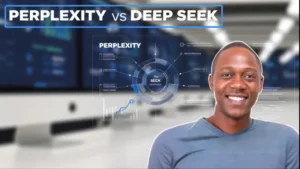The AI race is officially on.
Anyone who’s been paying attention knows OpenAI is the undisputed giant in this space. It raised a staggering $6.6 billion just last year and now boasts a valuation nearing $160 billion. That kind of war chest gives it an edge in talent, infrastructure, and research – the holy trinity of tech dominance.
The U.S. government, under both Trump and Biden, has doubled down on efforts to keep America at the forefront of AI. One big move? Restricting chipmaker Nvidia from selling AI-optimized chips to China. Nvidia – now a superstar stock up 900% in a single year – builds the GPUs powering most of today’s AI models. But the U.S. wants to keep those high-performance chips stateside to maintain the lead.
Enter DeepSeek: China’s OpenAI
But China isn’t sitting quietly on the sidelines. Toward the end of last year, they launched their own version of OpenAI – a model I call the “Chinese OpenAI,” officially named DeepSeek.
And it’s causing waves.
DeepSeek is reportedly as capable as models like OpenAI’s GPT, Meta’s LLaMA, and even Google’s Gemini, depending on the use case. What’s more jaw-dropping is that while OpenAI spent billions, DeepSeek was developed on a shoestring budget – about $300 million. That’s just 1/20th the cost.
Even more interesting? It’s open-source. Anyone can use it, modify it, and build on top of it – a sharp contrast to OpenAI’s closed model. Meta had already disrupted the space by open-sourcing LLaMA, believing that collaboration and community-driven innovation is what will actually push AI forward.
And here’s where it gets fascinating: despite U.S. sanctions banning Nvidia from selling its latest chips to China, Chinese developers used older Nvidia gaming GPUs – originally made for graphics cards – to build DeepSeek. Talk about turning lemons into lemonade.
But There’s a Catch
There’s one big asterisk: government influence.
In authoritarian regimes like China, state control can creep into anything – including AI models. So while DeepSeek might rival GPT in technical ability, politically sensitive content is likely to be censored or manipulated.
This makes DeepSeek a powerful but cautious pick for developers and companies who prioritize unbiased, unrestricted data – especially in journalism, academia, or political analysis.
Why Perplexity Took a Different Path
When everyone was caught up in the “who has the best LLM” battle, Perplexity zigged while others zagged.
Instead of trying to beat OpenAI at its own game, Perplexity took a bold move: don’t build the model – build a better experience on top of existing models.
And it’s paying off.
Perplexity’s CEO said it best – OpenAI had too much money to compete with directly, so instead, they focused on user utility. Think of Perplexity as the smarter Google Search: real-time web access, cited sources, and clean, usable output for researchers, marketers, and professionals. No fake links. No hallucinations.
Even better? Perplexity isn’t locked to one model. It can pull from OpenAI, Claude, LLaMA, DeepSeek – whatever works best for the task at hand. That’s a massive advantage in terms of flexibility and cost.
The Real Shift: LLMs Are Becoming Commodities

Here’s the kicker: everyone – from Google to Amazon, Meta to Microsoft – is building or releasing their own LLMs. And some, like Meta, are going open-source. That means soon, having an LLM won’t be special. What will matter is what you do with it.
Perplexity saw this early. That’s why they focused on creating tools, platforms, and apps that sit on top of these models. Because the true business value lies in application, not infrastructure.
Even OpenAI’s $20/month ChatGPT subscription starts looking shaky when a free tool like DeepSeek can deliver similar results – especially if you’re building at scale.
Final Thoughts: What This Means for Businesses
The AI gold rush isn’t about who builds the model anymore. It’s about who builds the best tools, apps, and solutions using those models.
If you’re a business – whether in marketing, healthcare, education, finance, or even retail – this is your window of opportunity.
You don’t need billions in funding or a team of PhDs to play in the AI space anymore. Thanks to open-source LLMs like DeepSeek and LLaMA, you can build intelligent, automated, and scalable tools for your clients or your operations without breaking the bank.
Imagine this:
- A marketing agency uses DeepSeek to generate 100+ personalized posts a day for its clients.
- A law firm uses LLaMA to automate document summaries and client queries.
- A financial services firm builds an AI chatbot that pulls from multiple models to give real-time, cited investment advice.
This is AI as infrastructure, and it’s already here.
So while OpenAI, Google, and China battle it out at the top – the real winners might just be the small and mid-sized businesses that figure out how to build value on top of all this power.






